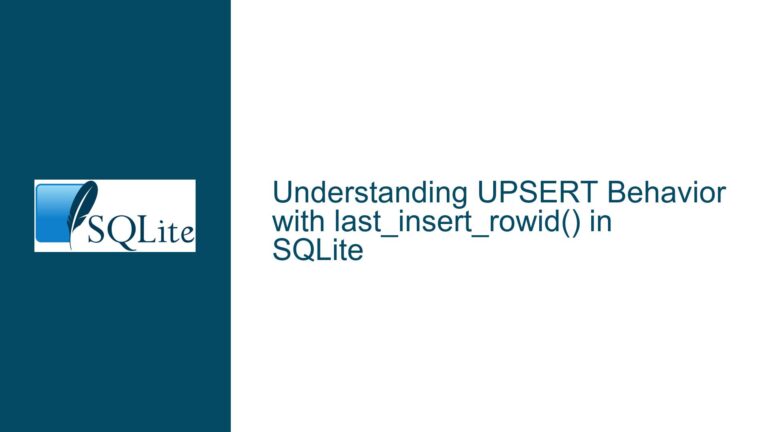FTS5 MATCH Query Unary NOT Operator Limitation and Workarounds
Understanding the Absence of Unary NOT in FTS5 Search Queries
Issue Overview
The SQLite FTS5 extension provides powerful full-text search capabilities, but it lacks explicit support for a unary NOT operator within the MATCH query syntax. Users attempting to exclude all records containing a specific term or phrase face a critical limitation: the NOT operator in FTS5 requires a left-hand operand (a valid query term) to function. For example, MATCH 'query1 NOT query2' works because query1 is the left-hand operand, but MATCH 'NOT query' is invalid because there is no preceding term.
This limitation becomes problematic when developers need to programmatically generate search queries where the application controls only the text inside the MATCH clause. The logical alternative—using NOT MATCH outside the query string—is not viable because it bypasses FTS5’s tokenization and indexing logic, leading to inefficient or incorrect results. The core challenge is to simulate a "match all documents except those containing <query>" behavior within the FTS5 query syntax.
Root Causes of Unary NOT Restrictions in FTS5
Possible Causes
FTS5 Query Syntax Design:
The FTS5 query language is optimized for binary operations (e.g.,AND,OR,NOTbetween two terms). The parser expects theNOToperator to follow a valid term or subquery. A standaloneNOTviolates this expectation, resulting in syntax errors or undefined behavior.Indexing and Tokenization Constraints:
FTS5 builds inverted indexes based on tokenized content. A "match everything" query would require iterating through the entire index, which contradicts the efficiency goals of full-text search. Supporting unaryNOTwould necessitate a universal wildcard (e.g.,*), but FTS5 does not recognize a wildcard as a valid standalone term.API and Architecture Boundaries:
SQLite’sMATCHoperator is designed to pass the query string directly to the FTS5 module. External SQL-level operators likeNOT MATCHoperate outside FTS5’s tokenization rules, making them incompatible with scenarios where the search logic must remain encapsulated within the FTS5 engine.
Implementing Workarounds for Unary NOT Logic in FTS5
Troubleshooting Steps, Solutions & Fixes
Workaround 1: Leveraging a Dummy Column with a Universal Token
Concept: Introduce a synthetic column in the FTS5 table that contains a predefined token (e.g., ALL). This token acts as a universal match, enabling the NOT operator to exclude unwanted terms.
Steps:
- Schema Modification:
Add a dummy column to the FTS5 table. For example:CREATE VIRTUAL TABLE documents_fts USING fts5( content, dummy_column ); - Data Insertion:
Populate thedummy_columnwith a consistent token (e.g.,ALL) for all rows during insertion:INSERT INTO documents_fts (content, dummy_column) VALUES ('Sample text', 'ALL'); - Query Construction:
Use the dummy column as the left-hand operand for theNOToperator:SELECT content FROM documents_fts WHERE documents_fts MATCH 'dummy_column:ALL NOT content:unwanted_term';
Advantages:
- Avoids post-processing (e.g., trimming appended tokens).
- Maintains FTS5’s tokenization and ranking logic.
Limitations:
- Requires schema changes and data migration.
- Increases storage overhead due to the dummy column.
Workaround 2: Subquery-Based Exclusion with NOT IN
Concept: Use a subquery to fetch IDs of records containing the unwanted term and exclude them from the main result set.
Steps:
- Identify Excluded IDs:
SELECT rowid FROM documents_fts WHERE documents_fts MATCH 'unwanted_term'; - Exclude Matching Rows:
SELECT * FROM documents_fts WHERE rowid NOT IN ( SELECT rowid FROM documents_fts WHERE documents_fts MATCH 'unwanted_term' );
Advantages:
- No schema or data modifications required.
- Straightforward implementation.
Limitations:
- Performance degradation on large datasets due to nested queries.
- Bypasses FTS5 optimizations for complex queries.
Workaround 3: Exploit Existing Tokens as Universal Matches
Concept: Identify a token that exists in all documents (e.g., a common word or punctuation) and use it as the left-hand operand for NOT.
Steps:
- Identify a Universal Token:
For example, if all documents contain the word "the", use it in the query:SELECT content FROM documents_fts WHERE documents_fts MATCH 'the NOT unwanted_term'; - Validation:
Ensure the token truly exists in all documents to avoid excluding valid records.
Advantages:
- Minimal changes to existing schemas or queries.
Limitations:
- Relies on the presence of a consistent token across all documents.
- Fails if the universal token is absent in any row.
Workaround 4: Hybrid Approach with External Filtering
Concept: Combine FTS5’s MATCH with external filtering using SQL’s NOT LIKE or NOT GLOB.
Steps:
- Broad FTS5 Filter:
SELECT * FROM documents_fts WHERE documents_fts MATCH '*' AND content NOT LIKE '%unwanted_term%';
Advantages:
- Simple to implement for small datasets.
Limitations:
- Inefficient for large datasets due to full-table scans.
- Lacks tokenization awareness (e.g., matches substrings unintentionally).
Final Considerations:
- Performance: The dummy column method (Workaround 1) is optimal for large-scale applications due to FTS5’s indexing.
- Maintainability: Subquery exclusion (Workaround 2) suits applications with minimal schema flexibility.
- Accuracy: Token-based approaches (Workaround 3) require rigorous validation of universal token presence.
By understanding FTS5’s syntactic constraints and strategically combining SQL features with FTS5’s capabilities, developers can effectively simulate unary NOT behavior without compromising performance or maintainability.






